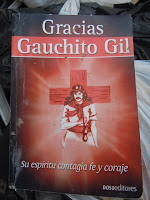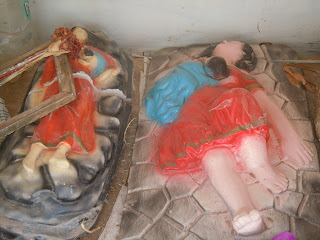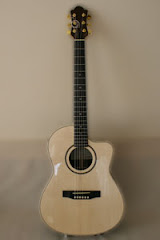We left Salta on December 21st with an imposing distance (1300km) separating us from Mendoza, where our sister Alicia was set to arrive on January 1st. Nearly all paved, mostly flat, we set out with clear goals, and long cycling days. This would be our biggest cycling push since crossing the Yucután Peninsula 19 months ago.
leaving Salta, we encountered exercise areas like this one. next to giant Jesus.
on the way towards Cafayate, our first destination/supply point along this route
we didn't realize that this apparent greenery was going to fade and disappear all the way to Mendoza
now in the Quebrada de las Conchas, a gorgeous natural reserve along the highway
Mitred Parakeet seen in the reserve
....heading up into Quebrada de las Conchas...
in the Garganta del Diablo (Devil's Throat), an incredible rock formation/amphitheatre so named for the demonic echoing that can happen here.
Tom carefully downclimbing from the top of the Devil's Throat, barefoot
that gash in the geology is the entrance to the Garganta del Diablo
...this was delightful riding...
...these cliffs are home to hundreds of...
...Burrowing Parrots!
... very Canyonlands-like scenes...
just outside Cafayate, we met up with Highway 40, the legendary longest-road in Argentina that heads down along the precordillera all the way to southern Patagonia. We are meeting it here around kilometer 4340, and we will be on it the majority of the way to Tierra del Fuego.
in Tolombon, a parched traveller's dream: a small quiet village with a pool in the center of its shady square! We were here for 5 hours or so, blissed out.
we ran into fierce headwinds along here, which reminded us more of Bolivia than the often-imagined lush Argentina that we thought we would be in. In fact, this whole stretch (1300km) is 95% scorched-earth desert. This realization settled heavily upon us.
a rare thunderstorm near Hualfín; lightning struck less than 1km from where we were riding through, enormous sky-illuminating bolts that had us shaking, and feeling very very alive.
at El Eje, we spent the night in a construction project above a service station while it rained outside
Burrowing Owl
...blooming cactus in these canyons... called cardones in argentina, they live to be hundreds of years old...
along this stretch we started seeing lots of roadside shrines like this one, slightly puzzling...
descending this canyon to Belén
we never saw one of these in Peru, but this is a Peruvian Dog (mythical rumored dog of the Incas) seen in Belén. Hairless except for its head and a tuft on its tail... it reminded us of Ren more than anything. He kind of behaved like Ren, too.
mostly-flat, easy riding, but interminable in a way, especially since we had varying-strength headwinds along this whole segment
this shrine was so ostentatious we stopped to check it out. And learned all kinds of interesting things...
...the shrine is to Gauchito Gil, and the faithful leave offerings of beer bottles, wine, coca leaves, money, car and motorcycle parts, cigarrettes, etc. etc.. In a way it reminds us of the shrines to Santa Muerte in Mexico and San Simon in Guatemala, as well as the figure-less ones all over Colombia along roadways and high passes.
wWe found this book at the shrine, which explains the cult of Gauchito Gil. As the story goes, in the second half of the 19th century, when there were cruel civil wars occurring all over the country, he was a young gaucho (cowboy) from the province of Corrientes who deserted the army (he didn't believe in the fighting) and began robbing the rich landowners and helping the poor (Robin Hood-style). He was later captured and murdered unceremoniously by the army, who slit his throat and hung him in a mesquite tree along a road.
The classic image of Gauchito Gil. The cross represents his cruel death (Jesus-like), the blue shirt represents his love for Argentina, the red neckerchief symbolizes the manner of his death, and the metal balls on the string are the tool he used to steal cattle. His shrines are almost always found beneath mesquite trees.
an example of a thank-you note from a follower, it reads "thank you Gauchito Gil for keeping me healthy". According to the legend, Gil told his executioner at the moment of his death that when he (the executioner) returned home, he would find his young son terminally ill, but that his son would miraculously recover. This is in fact what happened, and when the news spread, Gil was nearly immediately a pagan saint. His cult continues growing. He is known as the protector of the open road, of travellers, the benevolent outlaw who helps the less fortunate.
our campsite in a wash. There were so many thorns here that Jeff had 5 punctures to fix in the morning.
Perhaps inevitable, but a prayer was made to Gauchito Gil, this on Xmas Day. After 11 punctures since entering Argentina, not to mention an exploded valve and some broken spokes (all suffered by Jeff), we figured it might do some good to beseech Gil...
the prayer is made by lighting a candle in the shrine, and asking Gil for the specific assistance you need.
more Burrowing Parrots, seen near San Blas
they get their name from the nests they burrow out of cliffsides and mudbanks
As if the Gauchito Gil cult wasn't enough, we found another one on this route, as extensive as the Gil cult! This one is to Difunta Correa. Her shrines typically feature lots of full and empty water bottles strewn about, in addition to car tires, amongst other things.
admittedly, we were puzzled when we saw this inside the shrine, the figures of Difunta Correa. A dead chaste-looking woman with an arm stretched out as if in desperate supplication, and always accompanied by a young boy who is feeding at her breast...


flag expressing thanks to Difunta Correa for a supposed intermediation between the supplicator and God. As the story of Difunta Correa goes (year 1835), she was a young woman (22y.o.) living in San Juan, Argentina, married and with a young son. The police commisioner took a fancy to her, and deported her husband to La Rioja, a city some 500km away. Although she refused the commissioner's advances, he made life miserable for her, and she fled to go join her husband. Unfortunately, the journey to La Rioja in that time (and today too, we swear) was a perilous one in endless desert, and she ran out of water. She climbed a small hill near Vallecito, and there she made a desperate final prayer to God that when she died her infant son could continue feeding (from her breast) and survive. Some time later, two muledrivers saw vultures circling in the air and assumed one of their animals had died. Instead, they found Difunta Correa lying there dead with her infant son sucking at her breast, alive. This "miracle" story soon spread all over the region and she instantly became a pagan saint.

city-block-like burial vaults seen at Pituil
more of the same cemetary
this more like a bread oven than a coffin
another shrine, to another saint (this one canonized at least, if not controversially): San Expedito. By this point, it has become clear that Argentina is full of saints and cults. And its true, there are many more even besides the three shown on this page.
his shrines seem to be accompanied by flower pots
San Expedito himself. It seems that he is the saint of rapidity, invoked for urgent causes, especially for dealers, sailors and students. His cult goes back to the middle ages, apparently.
our campsite for the night of December 25th
Tom showing off his sunburn
we drank some wine and played guitar for hours to celebrate
sunrise the following morning
en route to Chilecito
in Chilecito, we were hosted for an afternoon by Benito, owner of Hostal Paiman. Very friendly, he offered us showers, mate, a place to rest, and the opportunity to pick all the ripe plums we wanted from his plum tree:
leaving Chilecito at night, we encountered this sign ominously announcing the distance to our final destination, 4000km.
called criollos, we found these in a bread shop in Nonogasta. They are little pie-like pastries with quince filling. Delicious.
this species sang for us nearly this whole segment of the trip
In Sañogasta, we rested for the entire day in the park, where Jeff rebuilt his back wheel, tossing aside the one purchased in Colombia in June. This due to a completely unreasonable spate of broken spokes of late .
...entering Cuesta de Miranda, a beautiful canyon climb and pass...
... the most scenic riding since we descended towards Salta...
this area reminded us more of Utah than of Argentina
more desert; bullet holes in the kilometer marker
in Villa Union, the town square has a monument to grape-pickers, since vineyards seem to be the number one economic scene along this whole stretch
...another shrine to Difunta Correa, set on sandstone...
that´s a bike frame that a devotee has offered in the foreground. Her death due to thirst is the explanation for all the water bottles her followers leave.
these figurines as always evoke a morbid and puzzling emotion
...riding to great afternoon skyscapes...
sunrise between Guandacol and Chilecito
only 312 km more to Mendoza. Too bad the photo can't evoke the 45-Celcius (113F) temps we are riding through.
... great dusk colors...
in San Juan, we rested in a public plaza, happy to find a refuge with water and no thorns
the last stretch into Mendoza: flat, and with a headwind
finally, Mendoza, in the Plaza de Independencia. Here we had a reunion of sorts... with Jason (not seen since La Paz 7 weeks previous), and older sister Alicia (2.5 years since last seen, the entire trip)! Alicia has come down to Argentina for a 2-week vacation with her boyfriend Greg and we will be doing some excursions around Mendoza in the following days...



















































































































